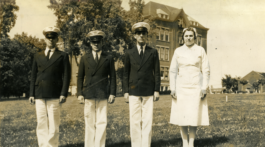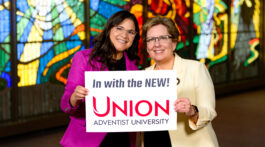Sabbath School Lesson for November 16-22, 2019
Overview
Nehemiah, chapter 10, contained the covenant, made and sealed by God’s people in God’s newly rebuilt city of Jerusalem. Our weekly examination of this important topic included…
- what a covenant is (Sunday)
- how covenants were used in the Bible (Monday)
- the literary structure of a typical covenant (Tuesday)
- the pledges made for this particular covenant (Wednesday)
- how the temple was to be taken care of, and why it was important for their spiritual growth (Thursday)
Introduction
There is much confusion in the Christian world when it comes to our covenant relationship with God. In its most basic form, however, a covenant is simply a legal agreement that establishes a relationship between two parties.
Human covenants, or contracts, down through history were mostly between leaders, who pledged to take care of the people under them, in return for their loyalty, often in the form of a tribute or tax.
In these covenants made with God, however, God was always faithful in keeping His promises, even when the people were not. The purpose of proclaiming blessings and curses was to alert the people when they weren’t fulfilling their promises in the covenant. The curses were merely the consequences of their faulty behavior.
The reason why covenants with God appear to change over time is because they are progressive in nature. God desires our loyalty in ways that are time-appropriate, but they always have the purpose of drawing us closer to Him.
Memory Text: ” ‘And because of all this, we make a sure covenant and write it; our leaders, our Levites, and our priests seal it.’ We will not neglect the house of our God.” Nehemiah 9:38; 10:39b, NKJV
After a thorough study of the Scriptures, followed by prayers of confession and repentance, the Jews were anxious to return to their former covenant relationship with God by pledging their agreement to the terms of the covenant, entered into by their predecessors.
Sunday: The Idea of the Covenant
Covenants were important for two reasons:
- They showed us that God has always desired to have a relationship with us.
- They gave the people an opportunity to show their desire to have a relationship with God.
Genesis 1 and 2 describe the very close relationship we enjoyed with God right after His creation of our world. Since sin entered the story in Genesis, chapter 3, however, there has been a constant struggle to have that relationship restored.
Adam’s descendants represent a mixed population, beginning with the divided loyalties of the families of Cain and Seth. At times, God’s faithful ones have become so small in number that they nearly became extinct. But God was able to preserve a line of followers that finally enabled our Savior to be born.
This happened, for instance, at the time of the Flood. The destruction of the world at that time consisted of a world that had already been ruined by the followers of Satan. It was the only way to preserve Noah’s family, so the faithful few could continue their mission of being His representatives.
Discussion Questions:
Read Nehemiah 9:36-38. What reason is given for making this covenant with God? How would a covenant help them?
Read Genesis 6:11-13, 18 and 9:16, 17. Why was distress also a reason for a covenant with Noah’s family? How did the rainbow help them remember their covenant?
Read Nehemiah 10:1, 28, 29. How did the giving of the Law to Moses increase the likelihood of restoring their relationship with God? Why do God’s covenants seem to change over time? What really changes in these agreements with His people?
Monday: Covenants in History
Seven covenants stand out in Bible history. Their everlasting nature assures us of their origin with God–from Adam down to the New Covenant. They are called “everlasting” sixteen times.
Just as the everlasting gospel was first presented to us in Genesis 3:15, however, and built upon over time, we must keep in mind that these everlasting covenants are also given to us progressively, in bits and pieces as we are able to use them most effectively. They don’t actually change. We do.
The same elements of salvation are found in these covenants though, which represent what our salvation means, and how it is achieved:
- Justification. “I will forgive their iniquity, and their sin I will remember no more.” Jeremiah 31:34 and Hebrews 8:12 (God wants to forgive us.)
- Reconciliation. “I will be their God, and they shall be my people.” Jeremiah 31:33 and Hebrews 8:10 (God wants to restore our broken relationship.)
- Sanctification. “I will put My law in their minds, and write it on their hearts.” Jeremiah 31:33 and Hebrews 8:10 (God wants us to live the gospel.)
- Mission. “…all shall know Me, from the least of them to the greatest of them.” Jeremiah 31:34 and Hebrews 8:11 (God wants us to spread the gospel of salvation to everyone, so as many as possible will be saved.)
The best results for mankind only come about as we take these basic themes and apply them to our lives, no matter when or where we live on this planet of ours.
Discussion Questions:
Read Genesis 9:15, 16 and 17:7, 8. Even though these were everlasting covenants, how were they different, and why?
Read Jeremiah 32:40. What was the purpose of God in renewing the covenant so many times with His people?
Read Jeremiah 31:33, 34. Where do you see specifically the elements of salvation in these words in Jeremiah–justification, reconciliation, sanctification, and our mission?
Tuesday: Covenantal Structure
As with all of our dealings with the God of the universe, we see an organized structure in the Creator’s pronouncements of a covenant with His followers. Whenever He renews our relationship, He is especially attentive to safeguarding the reality of the promises between God and us. He makes it as easy as possible for us to comply, by describing in detail what we must do and what He will do.
The typical pattern, followed in the statement of a biblical covenant, include…
- a preamble, introducing God to us
- a reminder of what God had done for us in the past
- a clear directive of what we should currently do
- a description of future consequences, depending on our compliance or noncompliance with God’s instructions (listed as blessings and curses)
- a list of witnesses
- any special provisions not already stated
Not many realize that the whole book of Deuteronomy is written with this covenantal structure in mind. After receiving the Law through Moses (in the book of Exodus) and setting up the sanctuary service (in Leviticus), God addresses the total covenantal relationship He wishes to build with the children of Israel following their Egyptian servitude.
Deuteronomy can be divided in the following way:
- Deuteronomy 1:1-5 preamble
- Deuteronomy 1:6-4:43 historical background
- Deuteronomy 4:44-26:19 laws to be kept
- Deuteronomy 27-30 blessings and curses, the consequences
- Deuteronomy 30:19 witnesses of the covenant
- Deuteronomy 31:9-13 special provision for reading of the law every seven years
Discussion Questions:
Read Nehemiah 10:28. How inclusive was the group who assented to the covenant? Who did it include? Why was it important to list everyone?
Read Nehemiah 10:29. Whose law did they pledge to keep? What was Moses’ role in the Law?
Read Joshua 24:14, 15. When, where, and why is it appropriate to make a firm choice and a public stand to follow God, such as this covenant renewal just before Joshua’s death? Why were their pagan gods their main stumblingblock, and what might be our greatest obstacle for making God a priority?
Wednesday: Pledges
Making these pledges to God in the tenth chapter of Nehemiah were necessary, in order for the people to know exactly what their responsibilities were in their walk with Him. God made it easy for them by specifying certain behaviors that were important for the continued restoration of their relationship with their Father God.
They were…
- not to engage in mixed marriages with unbelievers
- not to conduct business transactions on the Sabbath
- to practice debt cancellation, as prescribed every seventh year and in the jubilee year
- to focus on restoring the temple services
Two “do’s” and two “don’ts”. Two pledges that pertained mostly to human interactions (marriage and debt cancellation), and two that mostly pertained to their relationship with God (keeping the Sabbath and their care of the house of God).
Actually the Sabbath pledge of restricting business on that day may be seen as touching both their relationship with God and man. After all, the Sabbath was made for man (Mark 2:27); so its proper observance made it especially important in their walk with God.
The practice of debt cancellation would also improve their relationship with God, because neighbors would become closer when equality of life was promoted by such programs. They could more easily develop a healthy relationship with God, when they weren’t consumed by the unfairness of their situation, or the pride that being too wealthy might bring.
Discussion Questions:
Read Nehemiah 10:30 and 2 Corinthians 6:14. Why were mixed marriages of this sort forbidden by God?
Read Nehemiah 10:31 and Ezekiel 20:21. Why would buying and selling on the Sabbath be considered profaning the Sabbath?
Read Leviticus 25:18. Why was their observance of God’s instructions important for the people of Israel?
Thursday: The Temple
The fourth and final pledge for the people of Nehemiah’s day centered on the careful operation of the temple services.
Although they may have seemed to be overly concerned with the rites and physical maintenance of the temple, one must see this institution as the most tangible connection they have with God. The ministry of the priests there, in a very real sense, was the heartbeat of the nation.
The spiritual life of the people should have grown as they daily witnessed the solution to the sin problem, the death of the Lamb. Through the yearly services, culminating in the Day of Atonement, they would see a dramatic illustration of the plan of salvation unfold before them, reminding them that God was always in their midst, when they cultivated a life of faith by desiring Him in their hearts.
Discussion Questions:
Read Nehemiah 10:32, 33. Why were these offerings important for the people?
Read Nehemiah 10:38. Who were to receive the tithe monies?
Read Nehemiah 10:39. Why was the temple building itself not to be neglected? What would that neglect indicate? What type of dwelling should a church be today–extremely ornate, or shabbier than the homes lived in by the church members?
Final Thoughts
The book Prophets and Kings, p. 668, by Ellen G. White, depicts for us the joy that accompanied this covenant renewal at this time of Nehemiah. She brings it down to a personal level that any of His followers can experience.
“For those who are convicted of sin and weighed down with a sense of their unworthiness, there are lessons of faith and encouragement in this record. The Bible faithfully presents the result of Israel’s apostasy; but it portrays also the deep humiliation and repentance, the earnest devotion and generous sacrifice, that marked their seasons of return to the Lord.
Every true turning to the Lord brings abiding joy into the life. When a sinner yields to the influence of the Holy Spirit, he sees his own guilt and defilement in contrast with the holiness of the great Searcher of hearts. He sees himself condemned as a transgressor. But he is not, because of this, to give way to despair; for his pardon has already been secured. He may rejoice in the sense of sins forgiven, in the love of a pardoning heavenly Father. It is God’s glory to encircle sinful, repentant human beings in the arms of His love, to bind up their wounds, to cleanse them from sin, and to clothe them with the garments of salvation.”
Although there is much for the individual to be thrilled about when it comes to forgiveness of sin and the joy that accompanies our salvation, there is a reminder in this particular covenant that God’s house is not to be neglected either (Nehemiah 10:39). The blessing shouldn’t stop with us. God wants us to share our experience with others and that is best accomplished in the corporate body of Christ–in other words, His church (Hebrews 10:25).
How have we neglected the house of God? What more can we do to support the operation and improve, even beautify, the building where we worship? Let’s not deny God the opportunity to complete His mission on earth by neglecting the instrument He has chosen to represent Him.
Next Week’s Lesson: Trials, Tribulations, and Lists
To read the Sabbath School Lesson Quarterly or see more resources for its study, go to https://www.absg.adventist.org/
Other Outlook blogposts by Teresa Thompson, are at http://outlookmag.org/author/teresathompson/










